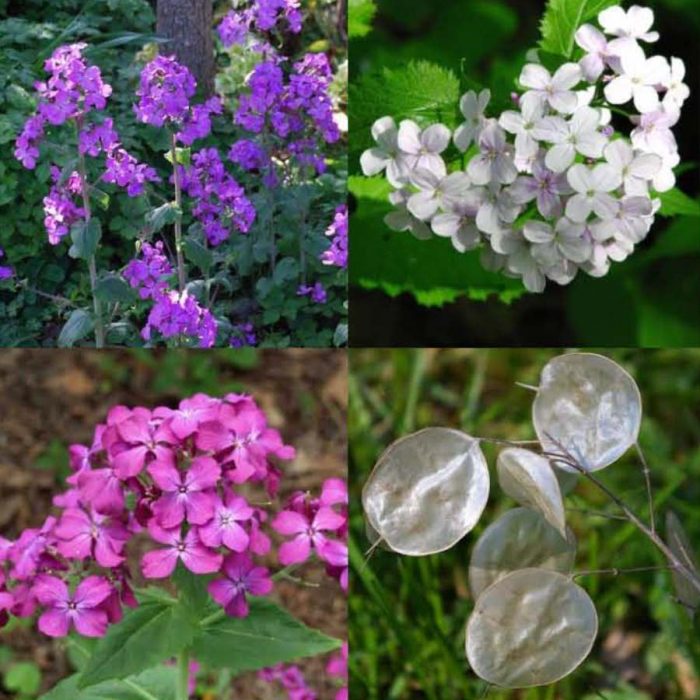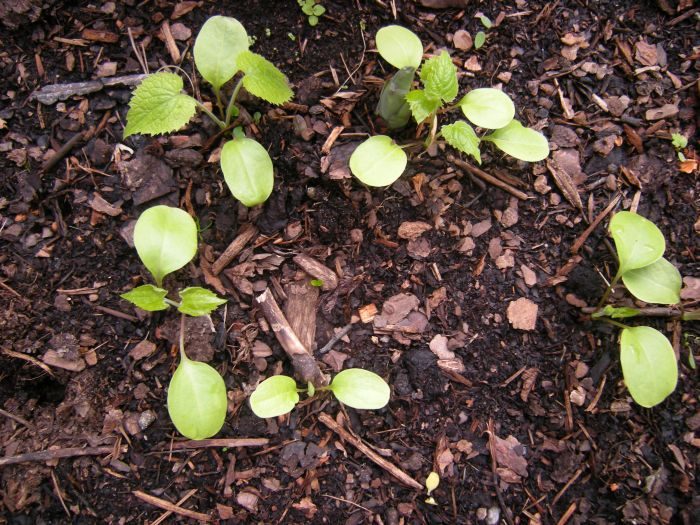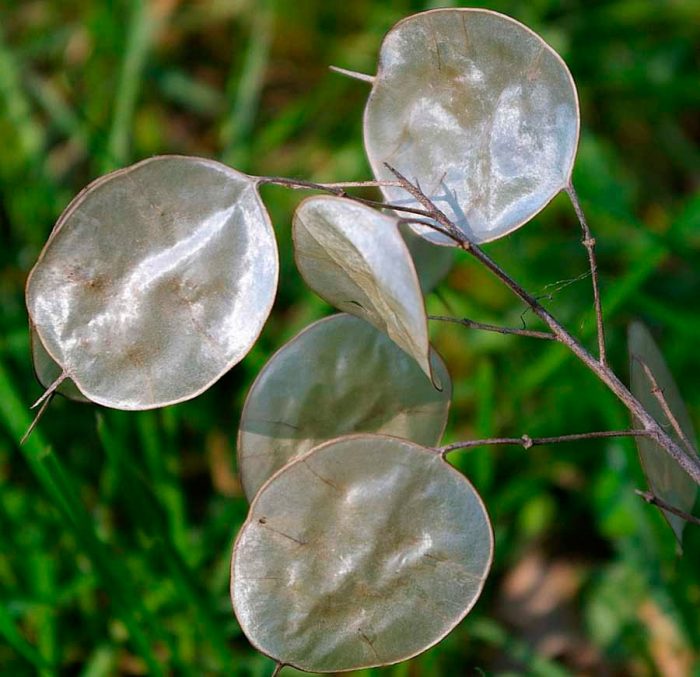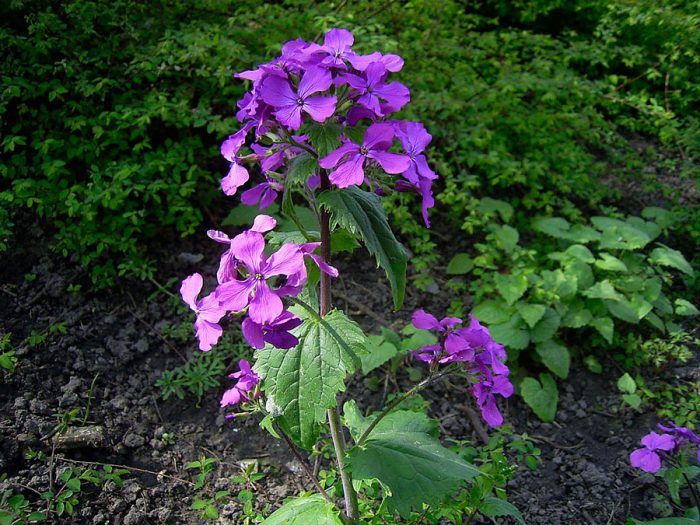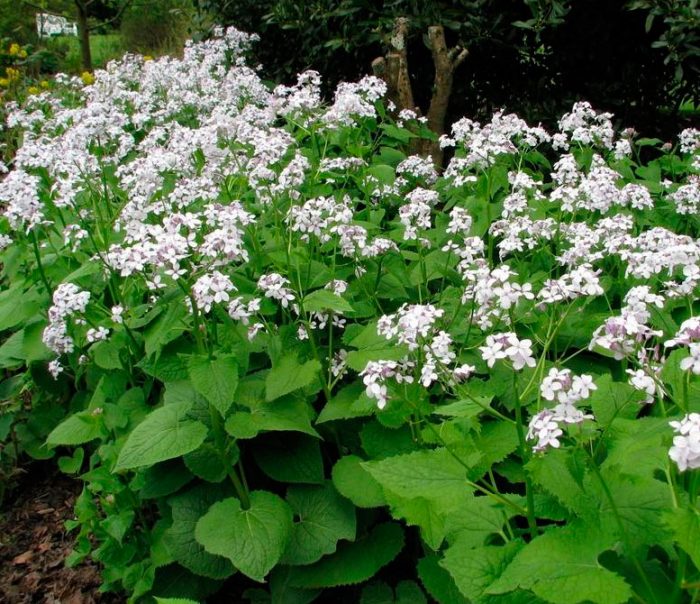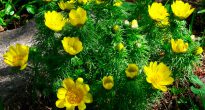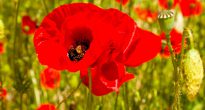The herbaceous perennial or annual plant Lunaria is a member of the Cruciferous family. The name of this plant was derived from the Latin word, which translates as "moon" because the shape of the fruit, as well as their mother-of-pearl tint, are similar to the full moon. This genus unites 4 species, but gardeners cultivate only 2:
- Annual lunar (Lunaria annua), or a flower-money, or moon grass. The homeland of this species is the southeast of Europe.
- The lunar is perennial, or reviving (lat. Lunaria rediviva). This rare endangered species is considered a relic of the Tertiary period. Its habitat decreases annually in size. Today it is found throughout Europe, and also relatively rare in North America. This flower prefers to grow on loose, slightly acidic, fertile soil saturated with humus, and also on gravelly or clay soil. Most often it can be found in deciduous forests. They began to cultivate it from the end of the 16th century. Then it was believed that this plant is the owner of magical properties, and people used it as a talisman, which helps to increase the state, and therefore they carried it with them.
Content
Lunar features
Solid sheet plates are large enough. The flower petals are large, as a rule, they are purple, but there are also white ones, they have long marigolds. Straight sepals are saccular at the base. The fruit is a large pod, flattened from the back, round or elliptical in shape, it has flat valves, and it sits on a peduncle that reaches 1.5 cm in length.One pod contains several flat two-row seeds with leathery wings.
How to plant in open ground
The annual lunar is considered, in fact, a biennial plant, the fact is that in the first year of growth, only the formation of leaves collected in a rosette occurs. The formation of a flowering shoot is observed only in the second year of life. After the seeds ripen, the plant's life cycle comes to an end.
The annual lunar is a light-loving plant, therefore, for planting it, you should choose an open and well-lit area, you can also plant it in light shade. The perennial lunar, on the other hand, cannot be grown in a sunny area; partial shade or shade is more suitable for it.Annual species have no particular soil preferences. But for planting perennial species, only moist, loose soil is suitable, which should be well fertilized; for this, humus is introduced into it (per 1 square meter from 3 to 4 kilograms), as well as lime for digging to a depth of about 0.2 m.
Both types of lunar, which are cultivated by gardeners, can be very easily propagated by cuttings, and also by seeds. Seeds of the annual species can, if desired, be sown directly into open soil in early spring. In the annual lunar, the color of the seeds is dark brown, and in diameter they reach 0.5-0.6 cm. Sowing should be done in pre-made grooves, while a distance of 0.3-0.35 m must be observed between the seeds, in this case seedlings do not need thinning. The first shoots, as a rule, appear after 7 days. In the last days of August, leafy rosettes should already form in the plants, and if desired, they can be transplanted to a new permanent place. If you grow an annual species through seedlings, then its flowering will begin already in the year of planting in open soil. Sowing seeds for seedlings should be done in March, and they should be planted in open soil in the last days of May, but only after return spring frosts are left behind.
Perennial seeds should be sown before winter or in spring time immediately in open soil, for this you need to choose a site located in the shade. If sowing is planned for spring, then the seeds will need to be stratified by placing them on a refrigerator shelf for vegetables for 6 weeks. The first seedlings will appear only in May, after which they will need to be thinned, keeping a distance between the bushes of at least 0.3 m. By the end of the summer period, the plants will have already developed 2 pairs of true leaf plates. Such a lunar will bloom en masse only next season. You also need to be prepared for the fact that in the autumn, starting from the second year of growth, the bushes can give quite abundant self-seeding.
Lunar garden care
You should take care of both the perennial and the annual species of the lunar in almost the same way, so the bushes need to be watered, weeded, fed, loosened, protected from pests and diseases if necessary. And it is also necessary to cut off flowers that have begun to fade in time and prepare bushes for winter, if necessary.
How to water
It is necessary to water the bushes in moderation, due to excessively strong soil moisture, rot may develop on the roots of the plant. However, during periods of prolonged drought, watering should be frequent as well as abundant. After the perennial species has finished ripening the fruits, all watering should be stopped. Watering is recommended either early in the morning, or after the heat of the day subsides (after about 4 pm). Water should be used only with settled and lukewarm water. Bushes react negatively to foliage moisture.
Top dressing
It is recommended to feed the perennial species of the lunar. Top dressing is carried out systematically 1 time per 4 weeks from spring to the second half of the summer period. For the lunar, both organic and complex mineral fertilizers are suitable.
Flowering and transplanting
Flowering of a perennial species is observed from May to June. Sometimes in August the bushes bloom again. Perennial lunar can be grown without transplantation for many years. It is recommended to replant the bushes in the last summer weeks.
Lunar after flowering
The annual species of the lunar is distinguished by a fairly high resistance to frost. Since in fact this species is biennial, it should be covered for the first winter. For this, the site is mulched with a thick layer using organic matter, and spruce branches are thrown over it.
When growing a perennial species in the southern regions, it may need shelter for the winter only if forecasters predict a very cold and little snow winter. In mid-latitudes and in areas with colder winters, the lunar should be covered for wintering.
Diseases and pests
Lunnik is distinguished by a rather high resistance to various diseases and pests. But if it is grown in conditions unfavorable for the growth of this culture, then aphids, cruciferous flea or cabbage butterfly can settle on the bushes. As soon as pests are noticed on the bushes, they should be treated with an insecticidal preparation. There should be at least two sprays, with the distance between them being 1–1.5 weeks.
Lunnik is not recommended to grow in those areas where representatives of the Cruciferous family grew before, for example: cabbage, daikon, mustard, horseradish, radish, radish, swede, etc. If liquid stagnation is observed in the soil, this can cause the development of a fungal disease ... The affected bushes must be treated with a fungicide solution, while mandatory re-treatment is carried out after 1.5 weeks. Before proceeding with the treatment, remove all infected parts from the bush, which must be destroyed.
If the bushes are provided with proper care, as well as follow all the agrotechnical rules of this culture, then they will be powerful and healthy, and any ailment will bypass them.
Types and varieties of lunnik with photos and names
It has already been said above that only 2 species of lunar are grown in culture.
Annual lunar (Lunaria annua)
This species comes from the southeastern regions of Western Europe. Gardeners cultivate it as a biennial. The height of the bush is about 0.6 m. The alternate rough-hairy leaf plates have a broad-ovate shape, they can be petiolate or sessile. The terminal brushes consist of flowers, painted in purple, lilac or white. When the plant blooms, the formation of flat seed bolls with an oval shape is observed on the bush, outwardly they are similar to pearlescent coins. The capsules contain seeds that ripen by September. Popular varieties:
- Pearl... The color of the flowers is lilac.
- Alba... The flowers are white.
- Variegata... The color of the flowers is lilac-pink, and the leaf plates are variegated.
- Munstead Purple... Fragrant flowers have a lilac color.
Lunar (Lunaria rediviva)
This perennial plant naturally occurs in deciduous forests of northern and central Europe, as well as in the Balkans. This species was introduced to North America. This species is the oldest plant and is a representative of the flora of the Tertiary period. Today its gradual extinction is observed. The height of the bush is about 100 cm. Straight shoots are branched in the upper part, and their surface is covered with small pile. The upper leaf plates are alternate, sessile and have an oval shape, the lower ones are opposite, heart-shaped and serrated along the edge. Panicle-shaped inflorescences consist of fragrant flowers of purple color, reaching 40 mm in diameter. The fruit is an oval-lanceolate pod, reaching 50 mm in length and having a sharpness at both ends. Cultivated since 1597.


